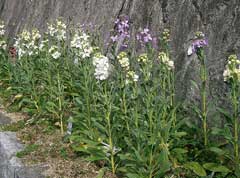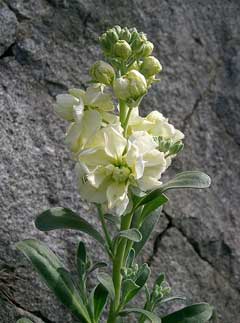 |
|
http://commons.wikimedia.org/wiki/User:KENPEI |
 |
| http://commons.wikimedia.org/wiki/User:KENPEI |
Translate this page:
Summary
Bloom Color: White. Main Bloom Time: Early fall, Late summer, Mid summer. Form: Upright or erect.
Physical Characteristics

 Matthiola incana is a ANNUAL/PERENNIAL growing to 0.6 m (2ft) by 0.3 m (1ft in) at a fast rate.
Matthiola incana is a ANNUAL/PERENNIAL growing to 0.6 m (2ft) by 0.3 m (1ft in) at a fast rate.
See above for USDA hardiness. It is hardy to UK zone 6 and is not frost tender. It is in flower from May to July, and the seeds ripen in August. The species is hermaphrodite (has both male and female organs) and is pollinated by Bees, Lepidoptera (Moths & Butterflies). The plant is self-fertile.
It is noted for attracting wildlife.
Suitable for: light (sandy), medium (loamy) and heavy (clay) soils and prefers well-drained soil. Suitable pH: neutral and basic (mildly alkaline) soils. It cannot grow in the shade. It prefers moist soil. The plant can tolerate maritime exposure.
UK Hardiness Map
US Hardiness Map
Synonyms
Cheiranthus incanus.
Plant Habitats
Cultivated Beds;
Edible Uses
Edible Parts: Flowers Leaves Seedpod
Edible Uses:
Flowers - eaten as a vegetable or used as a garnish, especially with sweet desserts[183]. Highly fragrant[183]. Seedpods[105, 183]. Used as a famine food when all else fails[177].
References More on Edible Uses
Medicinal Uses
Plants For A Future can not take any responsibility for any adverse effects from the use of plants. Always seek advice from a professional before using a plant medicinally.
Antidote Aphrodisiac Bitter Diuretic Expectorant Stimulant Stomachic Tonic
The seeds are aphrodisiac, bitter, diuretic, expectorant, stimulant, stomachic and tonic[240]. An infusion has been used in the treatment of cancer and when mixed with wine it has been used as an antidote to poisonous bites[240].
References More on Medicinal Uses
The Bookshop: Edible Plant Books
Our Latest books on Perennial Plants For Food Forests and Permaculture Gardens in paperback or digital formats.

Edible Tropical Plants
Food Forest Plants for Hotter Conditions: 250+ Plants For Tropical Food Forests & Permaculture Gardens.
More

Edible Temperate Plants
Plants for Your Food Forest: 500 Plants for Temperate Food Forests & Permaculture Gardens.
More

More Books
PFAF have eight books available in paperback and digital formats. Browse the shop for more information.
Shop Now
Other Uses
References More on Other Uses
Cultivation details
Landscape Uses:Border, Container, Foundation, Massing. Succeeds in ordinary garden soil[1]. Prefers a fertile neutral or slightly alkaline soil in full sun[200]. Plants grow best in a sandy soil in a warm, sheltered position[260]. A very ornamental plant[1], it is also a good butterfly plant[17]. Plants are usually biennial or short-lived perennials and are normally grown as annuals in the garden[188]. The wild plant is a perennial with an almost shrubby nature. Garden forms have been bred to have annual or biennial characteristics[260]. The flowers have a strong sweet scent[245]. Special Features:
Suitable for cut flowers, Fragrant flowers.
References Carbon Farming Information and Carbon Sequestration Information
Temperature Converter
Type a value in the Celsius field to convert the value to Fahrenheit:
Fahrenheit:
The PFAF Bookshop
Plants For A Future have a number of books available in paperback and digital form. Book titles include Edible Plants, Edible Perennials, Edible Trees,Edible Shrubs, Woodland Gardening, and Temperate Food Forest Plants. Our new book is Food Forest Plants For Hotter Conditions (Tropical and Sub-Tropical).
Shop Now
Plant Propagation
Seed - sow early spring in a greenhouse[1]. Germination usually takes place within 2 weeks. When they are large enough to handle, prick the seedlings out into individual pots and plant them out in the summer. The seed can also be sown outdoors in situ in mid to late spring.
Other Names
If available other names are mentioned here
Native Range
TEMPERATE ASIA: Cyprus EUROPE: Bosnia and Herzegovina, Greece, Croatia, Italy (incl. Sardinia, Sicily), Montenegro, Slovenia, France (s. & Corsica)
Weed Potential
Right plant wrong place. We are currently updating this section.
Please note that a plant may be invasive in one area but may not in your area so it's worth checking.
Conservation Status
IUCN Red List of Threatened Plants Status :

Growth: S = slow M = medium F = fast. Soil: L = light (sandy) M = medium H = heavy (clay). pH: A = acid N = neutral B = basic (alkaline). Shade: F = full shade S = semi-shade N = no shade. Moisture: D = dry M = Moist We = wet Wa = water.
Now available:
Food Forest Plants for Mediterranean Conditions
350+ Perennial Plants For Mediterranean and Drier Food Forests and Permaculture Gardens.
[Paperback and eBook]
This is the third in Plants For A Future's series of plant guides for food forests tailored to
specific climate zones. Following volumes on temperate and tropical ecosystems, this book focuses
on species suited to Mediterranean conditions—regions with hot, dry summers and cool, wet winters,
often facing the added challenge of climate change.
Read More
Expert comment
Author
(L.)R.Br.
Botanical References
17200
Links / References
For a list of references used on this page please go here
Readers comment